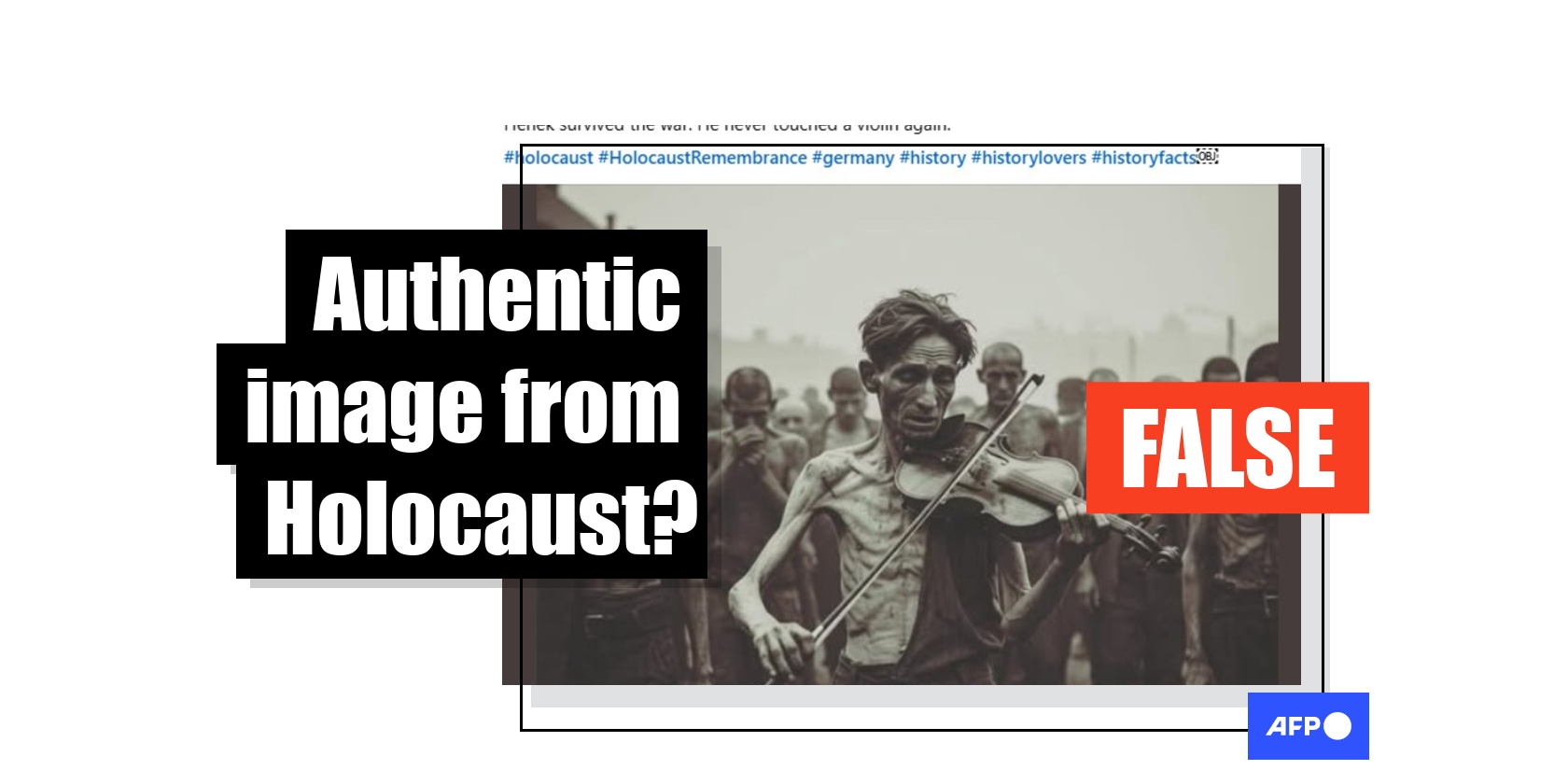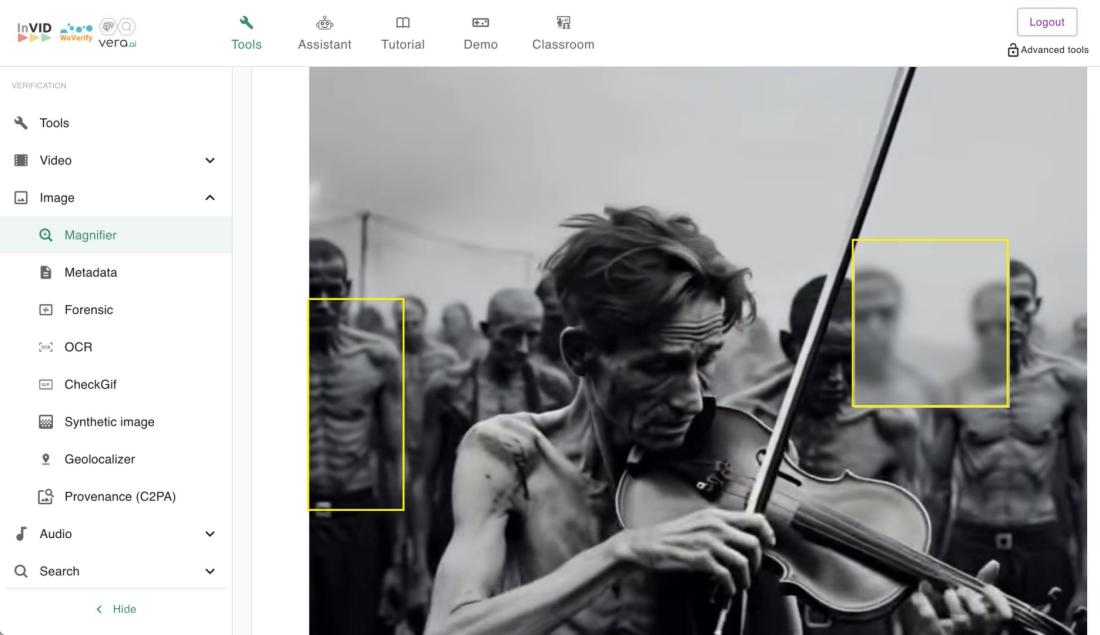
AI images of Holocaust violin players circulate online
- Published on July 31, 2025 at 23:29
- 6 min read
- By Magdalini GKOGKOU, AFP Greece
- Translation and adaptation Caleigh KEATING , AFP USA
"Henek, a violinist, was forced into the camp orchestra. His role: to play music as fellow prisoners were led to the gas chambers. He played 'Schubert's Serenade' with tears streaming down his face, bow trembling in his hand," a July 4, 2025 post on Facebook says. "One girl turned and whispered, 'Your music is the last thing I'll hear. Thank you.'"
The post shows an image of a gaunt man playing the violin with emaciated figures standing behind him. "Henek survived the war. He never touched a violin again," the post, which generated more than 12,000 likes and 5,000 shares, claims.

The image was shared across numerous other accounts on Facebook, as well as on X, Instagram, Threads and YouTube. It spread in multiple languages including Greek, French and Bulgarian.
Further keyword searches reveal that "Henek" is just one of many fake characters featured in fabricated narratives about violin players including "Eliska Varga," "Miriam Grünbaum," "Eliezer," "Jakob," "Eli Grunfeld," "Leon," "David Morgenstern" and multiple images of men apparently named "Eli Weiss."

The images follow an alarming trend of content creators churning out AI-generated content for money, targeting Westerners' emotional reactions to the Holocaust, in which six million Jewish people were killed (archived here).
The Auschwitz-Birkenau State Museum repeatedly condemned the content (archived here) -- also lodging complaints with Facebook owner Meta over the posts. But it said the technology giant did not respond.
The United Nations Educational, Scientific and Cultural Organization (UNESCO) warned of the dangers of false Holocaust content in a 2024 report, which said AI-generated posts can warp historical narratives and fuel anti-Semitism (archived here).
While music was an integral part of everyday life in almost all the Nazi-run camps, with prisoners being forced to either sing or play instruments (archived here), both the image and the story shared on social media are fabricated.
Visual inconsistencies
AFP identified several visual inconsistencies in the image of "Henek."
The violinist seems to have square-like knuckles that are disproportionate in size.
One figure in the background only has three fingers.

The fourth string of the violin also disappears at the bottom part of the instrument.

His appearance is also inconsistent with the other figures in the image. "Henek" has a head full of hair while those in the background have their heads shaved.
A shirt clings to the violinist's torso while the majority of the prisoners are shirtless and wearing pants with a belt.
Both modes of dressing, however, differ from the blue and white-striped pants and jacket required in the Nazi-run camps (archived here).
Sybille Steinbacher, professor of contemporary history at the University of Vienna (archived here), said her doubts about the authenticity of the image were reinforced by the shirtless men depicted.
"Prisoners had to be clothed; there was no such thing as standing for roll call with a naked upper body," she said on July 23 to AFP.
Pawel Sawicki, deputy spokesperson for the Auschwitz Memorial (archived here), said in a July 24 email that prisoners "did not have belts and camp numbers were also sewn onto their trousers."
Sawicki also pointed out that in 1943 prisoners would have had tattoos with their numbers on their arms.

AFP also analyzed a video posted on Facebook, which pointed to further visual inconsistencies.
The InVID Verification Plugin magnifier tool reveals frames in the clip where the faces in the background appear blurry and zombie-like. The person to the left of the musician also looks as if he has no sternum or stomach, with ribs showing down to his belt.

Historical inaccuracies
Researchers flagged other historical inaccuracies pertaining to the story of "Henek."
On July 6, the Auschwitz Memorial account posted a screenshot of a false post on X, saying: "Publishing fake, AI-generated images of Auschwitz is not only a dangerous distortion. Such fabrication disrespects victims and harasses their memory" (archived here).
In a comment below the post, it pointed to inaccurate details in the story, including that it was improbable for a girl to have walked past a male violinist as the "men's orchestra played in the men's camp."
Publishing fake, AI-generated images of Auschwitz is not only a dangerous distortion. Such fabrication disrespects victims and harasses their memory.
— Auschwitz Memorial (@AuschwitzMuseum) July 6, 2025
If you see such posts, please don’t share them. Instead, follow the official @AuschwitzMuseum, where every name, every photo, and… pic.twitter.com/8sMBxvPkOt
Auschwitz-Birkenau museum historian Jacek Lachendro (archived here) said that some historical accounts mention the men's orchestra in Birkenau playing while newly arrived Jews were being led to the gas chambers or while "prisoners were being led to the place of their execution by hanging or shooting (but not during the execution itself)." However, he emphasized that the musicians did not play in these situations "as a rule."
Elise Petit, whose research focuses on music within the Nazi camp system, agreed, telling AFP on July 21 that musicians mainly "played close to the gate when prisoners were marching in and out of the camp to work," (archived here, here and here).
The Auschwitz Memorial concurred with Petit's analysis, writing in a comment on the July 6 post that "Orchestras at Auschwitz did not play 'while men, women, and children were marched to their deaths'. Their main job was to play when columns of prisoners walked out to work and marched back to the camp."
AFP searched the Arolsen Archives -- a database containing victims and survivors of the Nazi regime -- for the name "Henek" and individuals mentioned in other posts, using a filter for "Konzenstrationslager Auschwitz" under "Place of Incarceration." But the search results do not match the identity of "Henek" or others depicted in the images and stories shared online.
AI Detectors
AFP analyzed the image with detection tools developed by cybersecurity company GetReal Lab, which indicated the image was synthetic.

AFP ran the image through the Hive Moderation AI detection tool, which found that the image is highly likely to contain AI-generated or deepfake content, with a 99.9 percent confidence level.

The first concentration camps, established in 1933 shortly after Adolf Hitler became chancellor, were primarily used to imprison opponents of Nazi policy. By the end of 1942, six extermination camps were in operation, including Auschwitz-Birkenau, following the Wannsee conference that formalized the Nazis' policy of extermination of Jews in occupied Europe.
Around 1.1 million people were systemically murdered in Auschwitz, making it the largest death camp. Approximately one million of those killed at Auschwitz were Jews, with Roma, Russian prisoners of war and Poles among the rest murdered.
AFP fact-checked other claims related to AI here.
Copyright © AFP 2017-2025. Any commercial use of this content requires a subscription. Click here to find out more.
Is there content that you would like AFP to fact-check? Get in touch.
Contact us




